Happy Tuesday dear Friends! I hope you had a wonderful start of the week.
In this past post I talked to you about dulce de leche, and I mentioned that this milk jam is the traditional filling for cornstarch cookies or alfajores de maizena. After the post, a few friends asked me how they could make dulce de leche, because they don’t live in countries where one can simply go and buy one jar at the supermarket.
So here I am, showing you three easy ways of making your own, the Argentinian way. Why the Argentinian way? Because you can find different versions of the same product pretty much all around Latin America, but if you read the components you will notice slight differences in the ingredients. For example, while in Argentina dulce de leche is made 100% with cow’s milk, traditional mexican dulce de cajeta is made with goat’s milk; and in Uruguay it generally includes cornstarch (which makes it thicker). It is also possible to find it outside of Latin America, for example in France (where it is called confiture de lait), in Israel (ribat jalav) and, I am told, even in India.
So how can one make dulce de leche, when it is not readily available for purchase?
There are three ways I know of, but only two of which I have tried:
I- By submerging a can of sweetened condensed milk in a pan full of water, and letting it boil for about 3 hours (in a normal pan) or 45 minutes (in a pressure cooker). If you use this method, you should remember that:
a) The can has to be completely covered in water at all times, otherwise any part that remains uncovered will not mutate into dulce de leche (as in the picture below)
b) Once the 3 hours have passed, make sure that the can is COMPLETELY cooled before opening it. If you open it when it’s still hot, the content will burst and there is a serious risk that you may burn yourself. So wait. Put in the fridge for faster cooling if necessary. But do not open it immediately!
This is what will be waiting for you when you open the can:
II- If the possibility of burning yourself scares you a lot, you can try Chef David Lebovitz’s method, which consists of baking sweetened condensed milk au bain marie, covered in aluminum foil. I haven’t tried it, but it does look like a safer option, and it takes less time than the original can version.
III- Make dulce de leche from scratch. It is not difficult to do so, and, though it is a bit time consuming because you need to watch it carefully, it is worth it. I must admit that, when I lived in Argentina, I didn’t do it very often, because there are so many good brands available that I didn’t see the point. But one day, when I was 21 years old, my father (who loved to cook) suggested that we tried, so we asked around for a recipe and we made our first batch of dulce de leche. This is the recipe I will share with you today.
To make 1 kilo of dulce de leche, you will need
– 5 litres of milk
– 1 kilo of sugar
– 1 vanilla pod (if you don’t have vanilla pods, you can use 1 tablespoon of vanilla extract)
– 1 tablespoon of bicarbonate of soda
– 1 big pan
– 1 wooden spoon
The preparation is very simple.
1- Put the milk in the pan. Make sure the size of the pan is twice as big as the amount of milk, because the preparation will rise once you add the bicarbonate of soda and, if it is too small, you run the risk of it overflowing the pan and making a big mess. In order to prevent this, I am told that one should put in the pan a few small glass balls (like the ones children play with), because this will prevent the preparation from rising too much.
2- Add sugar, all at once.
3- Stir the preparation and bring to the boil. Let it boil for 5 minutes, stirring constantly
4- Bring heat to the minimum, and add the vanilla pod and the bicarbonate of soda (I added 1 teaspoon because I was making half the preparation only)
5- Let the preparation boil at minimum heat, stirring every 10-15 minutes. It should look as in the picture below:
6- After about 1 hour, the milk will start to brown, and will look like this:
7-After another hour, it will become even darker, like this:
8- After around 1/2 hour, it will be thicker and darker and it will have considerably reduced. When it reaches this point, start stirring constantly for about 15 minutes.
This is the consistency it had at that point. It doesn’t look like it’s ready but, trust me, it almost is.
9- After 15 minutes, turn off the heat and continue stirring for another 5-10 minutes. What I like to do then is to transfer it to another pan (it cools faster). This is how it looked right after I transferred it:
As you can see, it still looks quite liquid, like a caramel sauce.
But all it needs is to cool down completely to reach the appropriate consistency.
10-Once it has cooled down, transfer it to a glass container and keep it in the fridge. This is how it will look after 3 hours in it:
Ready to eat and to add to preparations such as cookies, cakes, brownies, ice-creams, puddings, and so many more!
I hope that you will like it if you decide to make it.
Have a wonderful week!
If you want to know how to make dulce de leche repostero (baking dulce de leche), check this post

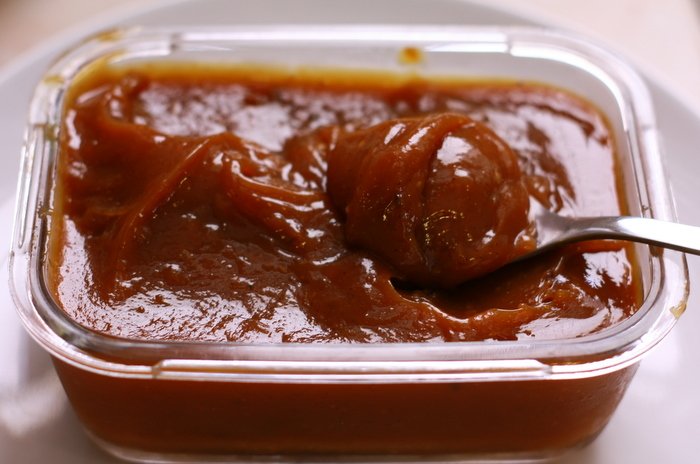








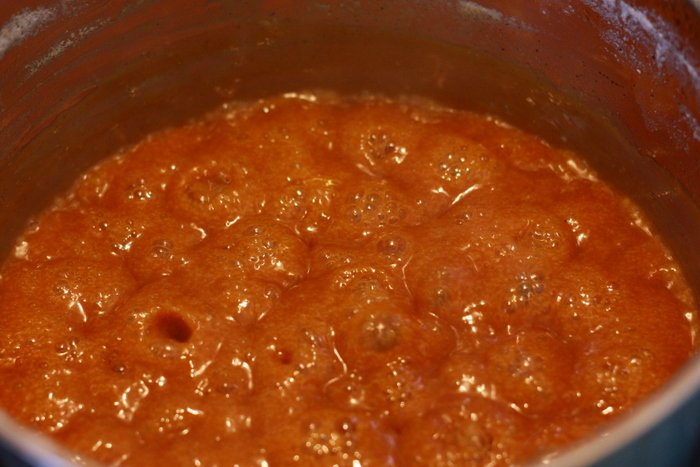
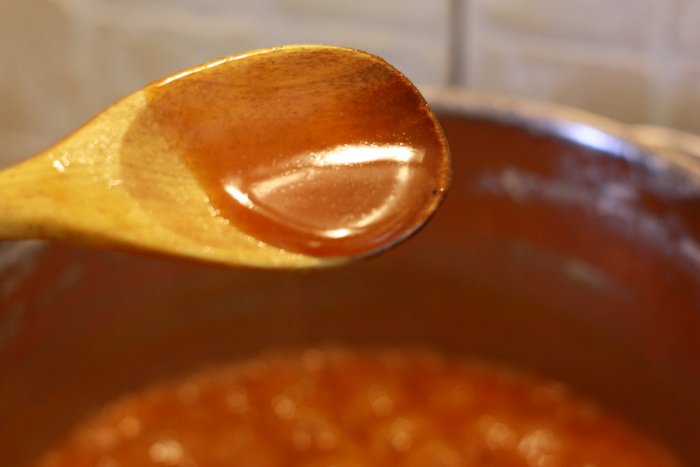
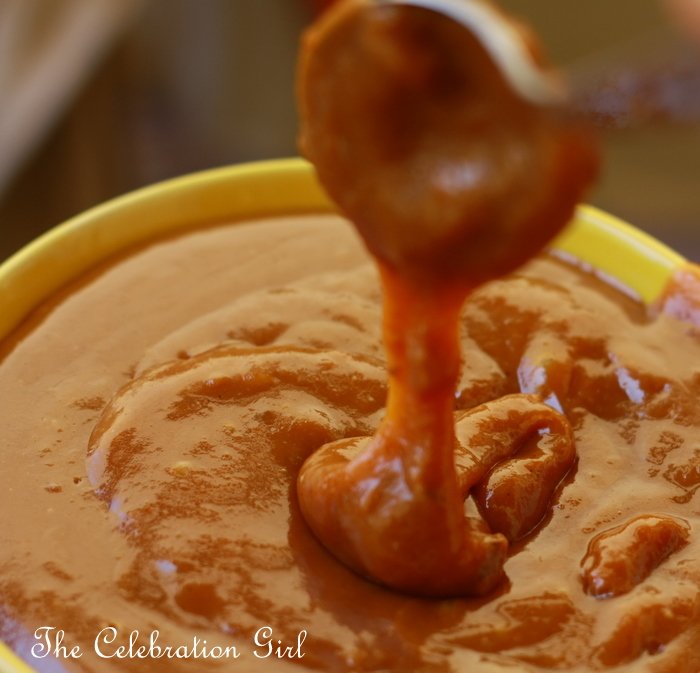


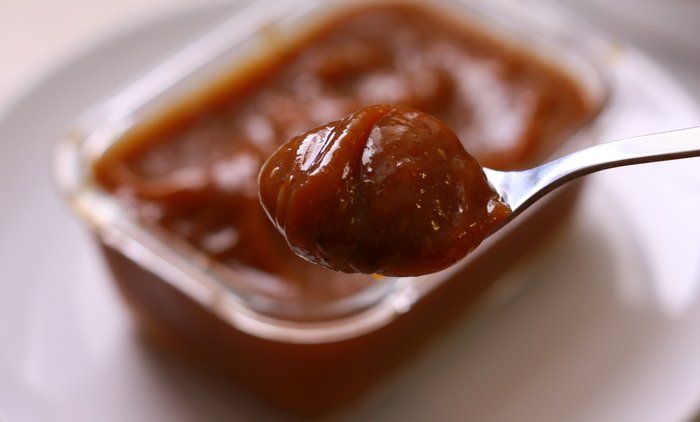
This sounds luscious. It would be fun to use it for cookie sandwiches. Would they have to be alfajores?
Hi Lisa! It is indeed luscious. It works well with any cookie, actually “alfajores” is the way we give to cookie sandwiches, so by making a sandwich with any cookie you will be making an alfajor! The flavor works particularly well with coconut, chocolate, vanilla, coffee and almonds. If you find it too sweet, I suggest mixing dulce de leche with cream cheese (philadelphia, for example).
Dulce de leche works also really well with ice cream (Try chocolate ice cream, with a spoon of dulce de leche, and crushed almonds or walnuts and you’ll be a convert forever 😉
Let me know how it goes!
Wow ! Entre esto y tu receta de los alfajores lo voy a tener que intentar. A mi esposo, le encantan, se vuelve loco . Cuando estaba en Barcelona siempre pasabamos por un localito de argentinos que vendia alfajores, y el se emocionaba porque siempre nos decian “Hola chicos”: Creo que asi saludan a todo el mundo pero a Mark le gustaba tomarselo personal. La ultima vez que trate de hacer dulces de leche, con mi prima, teniamos como 13 años y la verdad es que nos desesperamos y no funciono. La receta decia, “mezclar hasta que se vea el fondo del cazo”, pero la verdad es que eso de ver el fondo nunca sucedio y pasamos a otra cosa….
Si,si , prueben, prueben! Esta receta no hay manera de que salga mal, te lo prometo! (Qué habrá querido decir con “hasta que se vea el fondo del cazo”? Será hasta que esté tan espeso que al mover la cuchara puedas ver el fondo de la olla? Si es eso, el problema es que, al enfriarse, va a quedar durísimo!)
El “Hola chicos”sí, es una forma de saludar, qué lindo que a tu marido le haya gustado. Hace bastantes años conocí en mi ciudad, Cordoba, un chico holandés que estaba enamorado del modo de tratar de los argentinos. Estaba parando en un hostal muy familiar, y un domingo lo habian invitado a comer con toda la familia, más de 30 personas, y había quedado fascinado con la dinámica, el ruido, las risas, las bromas permanentes. Tambien le gustaba una costumbre muy nuestra de pasar por la casa de los amigos sin avisar y que siempre haya mate para compartir, tanto así que al volver a La Haya habia querido imponerlo entre sus amigos 🙂
Si, lo de ver el fondo del cazo se referia a que estuvera tan espeso que se vea el fondo de la olla. Y en esa receta si tenia que quedar porque estabamos tratando de hacer “jamoncillos”unos dulces tipicos mexicanos que son como cuadritos de dulce de leche, entonces para poder moldearlos tenia que quedar más espeso que para el dulce de leche (o cajeta, que si, es en efecto con leche de cabra, aunque en Mexico tambien hacemos mezcla de leche de cabra y vaca).
Aqui puedes ver los jamoncillos no se si los conozcas:
http://monbonmot.wordpress.com/2011/04/16/foods-from-around-the-world/jamoncillos/
Pero definitivamente un dia de estos intentamos los alfajores. 😉
ahhh, nosotros tambien tenemos unos cuadraditos parecidos!
Q maravilla de textura, Marce!!! Se la voy a pasar a mi hermana q vive en Panama y spre se lleva los potes de Dulce de leche San Ignacio. A ver si se anima!! Hermoso post. besotes
Gracias Pauli! Espero que tu hermana se anime, es re facil!
Oh God, this is too good to be true! We use this a lot in portuguese sweets – and now that I have a Bimby, I can cook it even faster! 🙂
I would choose the last method. One can not hurry perfection!
Thanks! I had no idea you use dulce de leche a lot in Portuguese sweets, let me know of it goes with the Bimby! 🙂
It definitely tastes much better. Thanks for commenting! 🙂
Marcela, it works wonderfully well with Bimby! It cooks it quickly, to the point and it’s easy easy! We use it a lot – not in traditional like convent sweets (centuries old), but in lots of modern recipes. Brigadeiros – you know – is of course one of them. (Portuguese traditional sweets are based on eggs and lots and lots of sugar). You have to come here one day (if you haven’t still), you’ll fall in love with our food! 🙂
Yes, now I remember, I had Brigadeiros in Brasil!
I would love to visit Portugal, I have seen pictures and it’s so beautiful 🙂
Be my guest! 🙂 I’m having an argentinian friend for dinner next Monday! Funny how the world is such a small place…
😀 Funny indeed. I know two persons from Portugal (from when I lived in Ivory Coast), and they are both from Porto! I must go, it’s a sign! 😉
Hi Marcela! Your dulce de leche looks beautiful. I tried making it once when I was living in Argentina (yes, I know, you can buy it absolutely everywhere there, but I was curious) and a friend of mine gave me an old family recipe (they had owned a dairy or something like that) and it came out tasting very baking-soda-y. Do you know what the baking soda is for? By the way, I´m currently in Colombia and here it´s called arequipe…I guess almost everyone has their own version!
Hi Eva! So, you lived in Argentina! Where?
The baking soda helps dulce de leche taste less sugary and it’s what gives it its distinctive brown colour. I never had any baking-soda-y dulce de leche, it must have had tons! :S
Let me know if you like it with my recipe!
As for everyone having its own version, you are absolutely right. The funny thing is that I grew up believing it was an Argentinian invention! There was a story going around about how the first time it was made was when Juan Manuel de Rosas’ housekeeper forgot milk and sugar in the stove and found it brown and “jammy” when she went back to the Kitchen…which given how common it is everywhere, I doubt it is true at all!
This is brilliant and I can’t wait to try it! I talked about it on my blog last week – hope you don’t mind!
Best,
Krysten
Clickable Party
Hey, I am Argentinian and living there (I mean, here in Argentina) at the moment and I have to say that it was LOVELY to see the recipe. My aunt used to make homemade dulce de leche from scratch (we called it dulce de leche casero) and it was divine!!! She was an excellent cook! You know, I´m not the most argentina lover argentinian but it just tickle me off when i read that there is dulce de leche in another countries… I know, we are supposed to share but it´s one of the things that makes us US! hahahahahahaha… still even though there are some other versions of dulce de leche around the world, I never tasted anything like ours… yeah yeah I´m proud of it! 🙂 In my book no cake is a decent cake if it has no dulce de leche a a filling! 🙂
Hola Natalia! Yo tambien soy Argentina, de Córdoba. Qué bueno que te haya gustado la receta y que te haya traido buenos recuerdos. Tu abuela lo hacía parecido?
Un abrazo!
Si, mucho no me acuerdo porque era chica yo cuando lo hacia, pero si que lo hacia bien caserito y quedaba para chuparse los dedos!!!! Sospeche desde un principio que podias ser argentina jajajajajajaja… sera que nos olemos? jajajajja Un gusto seguirte aca y en el diario de la trotamundos tambien!!!
Hi Krysten! Thanks for linking to my blog, I am glad that you liked it. Let me know how it goes once you try this recipe!
Pero si soy argentina confesa, está escrito en la página “acerca de mí”! 🙂
Encantada de encontrarnos por aquí, gracias por seguirme en ambos lados.
Voy a probar tu receta de dulce de leche de ya. Me ENCANTA el dulce de leche, y acá en China es super dificil de encontrar. Mil gracias!. Ya te contaré como me fue.
Qué bueno que te haya gustado la receta! Si, si, cuentame cómo te fue cuando la hagas, y cualquier duda que tengas no dudes en contactarme.
Qué interesante deber ser vivir en China, ahora mismo paso por tu blog para conocer más!
Hello hello!
Forgive my artery-clogging suggestion, but….
Can I use whipping cream instead of milk?
I don’t know, I am not sure cream would stand being heated for so long without curdling. That being said, if you are using full fat cream (or if you add a bit of cream to regular milk) you will end with a luscious, decadent super creamy consistency. Let me know how it goes if you do try it with cream!
This looks AMAZING! So easy and cheap – i can’t wait to try it!I also have a food blog i hope you’ll stop by sometime for some yummy trteas!! http://www.samahsrecipes.blogspot.com
Thank you! I’m glad you liked it!
Thank you for the recipe. I would die for Dulce de Leche. Maybe because I was born in Mar del Plata (Argentina). I want to try the Argentinian way. I remember that in high school an argentinian spanish classes internship showed us. But I have a question, in the pressure cooker, I suppose the can has to be covered with water also ? Thanks again ! Love your blog !
Hi! Nice to see you here!
And yes, the can has to be covered in water as well. You could also try it the traditional way in the pressure cooker (not from a can).
Have a nice day!
hi..!! I GROW IN ARGENTINA AND I KNOW…EXACT , WHAT MEANS FOR US…DULCE DE LECHE..!!! UUUUAAAUUUU ..!
BETER THEN THIS….. IS EAT AGAIN..!!!
MANY THANKS FOR SHOW THIS EASY WAY FOR MAKE .
D.D. L…I LIVE IN CHINA ,NOW, AND THIS WAY, WILL BE PERFECT..!!! THANKS ..!!! ALL PERFECT , ABOUT PHOTOS AND EXPLANATION..!! FELICITACIONES…!!!
OSCAR MASSA…
HOLA MARCELA..!!! SOS CORDOBESA..!!! QUE BUENO..!!
DE JOVEN, PASE MARAVILLOSOS MOMENTOS EN CORDOBA…GRAN CIUDAD Y MEJOR GENTE..!!!!
SOY OSCAR MASSA Y HOY Y YA HACE 10 ANOS VIVO EN CHINA…CERCA DE H.KONG….Y EN ESTOS LUGARES, —NO HAY DULCE DE LECHE…??NI DE CASUALIDAD..??
NO ENTIENDO LOS FABRICANTES, PORQUE NO VENDEN POR AQUI…ES EL MERCADO MAS GRANDE DEL PLANETA..!!!
PERO BUENO….VOY A INTENTAR QUE MI SRA.{BRASILERA} HAGA EL DULCE DE LECHE , CON LAS LATITAS DE NESTLE….Y DESPUES TE CUENTO..!!!! ABRAZOS Y BESOS..!!
OSCAR MASSA…
Hola Oscar! I’m so happy that you like this recipe. Let me know how it turns out and, if you are up for it, I would loooove it if you could share photos with me when you do it. Just tag me #marcelamaciasphoto in instagram or add them to my facebook page http://facebook.com/marcelamaciasphotography
Hello Marcia,
I am planning to make a big batch of Alfajores for friends to try. I was told and have searched a couple of recipes in making Dulce de Leche, most Argentinian recipes suggest to boil the can of condensed milk to 7 hours to get the right consistency and color. I have tried this, although it is time consuming, it does deliver the best color and consistency. I would like to have your opinion on this. If I do not mix the “7 hour finished” condensed milk with anything and use it as a filling for Alfajores, would it be too sweet or too rich?
Many thanks in advance and I hope to hear back from you. Thank you.
Regards,
Angel
Sorry for the typo I meant Marcela not Marcia
Hi Angel! No, it won’t be too sweet or rich. The only major variation will be color (it’ll be lighter) and the consistency won’t be as thick. Nothing else will change!